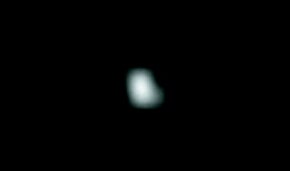 APL seen by New Horizons from 1.3 million kilometers in June 2006 | |
| Discovery[1] | |
|---|---|
| Discovered by | LINEAR |
| Discovery site | Lincoln Lab ETS |
| Discovery date | 9 May 2002 |
| Designations | |
| (132524) APL | |
Named after | Applied Physics Laboratory |
| 2002 JF56 | |
| main-belt[1][2] · (middle) background[3][4] | |
| Orbital characteristics[2] | |
| Epoch 27 April 2019 (JD 2458600.5) | |
| Uncertainty parameter 0 | |
| Observation arc | 27.41 yr (10,012 d) |
| Aphelion | 3.3163 AU |
| Perihelion | 1.8904 AU |
| 2.6033 AU | |
| Eccentricity | 0.2738 |
| 4.20 yr (1,534 d) | |
| 320.13° | |
| 0° 14m 4.56s / day | |
| Inclination | 4.1585° |
| 51.698° | |
| 261.87° | |
| Physical characteristics | |
| 2.5 km[5] | |
| S[6] | |
| 15.3[1][2] | |
132524 APL (provisional designation 2002 JF56) is a small background asteroid in the intermediate asteroid belt. It was discovered by Lincoln Near-Earth Asteroid Research in May 2002,[1] and imaged by the New Horizons space probe on its flyby in June 2006, when it was passing through the asteroid belt. The stony S-type asteroid measures approximately 2.5 kilometers (1.6 miles) in diameter.[5][6]
- ^ a b c d Cite error: The named reference
MPC-objectwas invoked but never defined (see the help page). - ^ a b c Cite error: The named reference
jpldatawas invoked but never defined (see the help page). - ^ Cite error: The named reference
Ferretwas invoked but never defined (see the help page). - ^ Cite error: The named reference
AstDys-objectwas invoked but never defined (see the help page). - ^ a b Cite error: The named reference
NH-2015was invoked but never defined (see the help page). - ^ a b Cite error: The named reference
CBETwas invoked but never defined (see the help page).